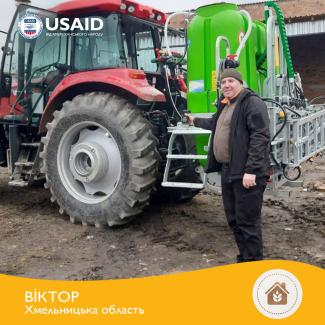Viktor, a farmer from Khmelnytskyi region, started out as an independent farmer 10 years ago. At first, he worked his own fields and those belonging to his close relatives. The harvest was just enough to feed a few pigs on his family farm, and he sold whatever was left at the market. However, his business was unstable. Pork prices were volatile, and his sales of surplus crops went to local farmers or middlemen at almost below-cost prices.
“I realized I either had to evolve or to close shop,” says Viktor. “I chose the first option.”
His neighbors suggested that he rented their land plots, and this increased the amount of land he farmed to a couple of dozen hectares. He bought basic equipment, and he registered his smallholding, under the name of Agro Victoria 2022. He also changed his sales approach; waiting until the harvest season was over to sell his grain at an attractive price. His business suddenly became profitable. With storage facilities on his property, Viktor was able to stockpile more grain than he could produce. This led him to cooperate with local farmers to store grain together. Both parties could benefit: as the owner, Viktor collected a fee for grain storage, while other farmers could hold their grain back until the prices went up. Victor planned to install a ventilation system that would further increase his storage capacity and improve the quality of the stored grain.
But then came Russia’s full scale war. Prices for inputs like seeds and fertilizer skyrocketed, while the challenges to exporting via Black Sea ports sent grain prices tumbling. Viktor and his fellow farmers managed to pull through thanks to the corn seeds they received from the USAID Agriculture Growing Rural Opportunities Activity (AGRO).
In the autumn, the farmers unloaded their grain harvest at the storage facilities, as usual. However, abundant rains in the autumn and above-freezing temperatures in early winter caused the stored grain to occasionally overheat. Without the ventilation that Viktor had planned to install in his storage units, large amounts of his and other local farmers’ collective harvest could simply rot away. The farmers had to dry over 1,400 tons of soybean, but all storage facilities available to them were full.
That was when Viktor learned about the USAID Agriculture Resilience Initiative in Ukraine (AGRI-Ukraine) and took advantage of the chance to store his grain in polymer silo bags. He packed the dried soybeans in the silo bags, strictly following the guidance of Hospodar Farm, USAID AGRO’s expert partner, and sold it later in January 2023 when the price was the highest.
“I had never taken part in international technical assistance projects before,” admits Viktor. “I did not think they were accessible for modest smallholders.”
Viktor and his fellow farmers are grateful to Hospodar’s experts for this new grain storage technology and for the opportunity to test its efficiency firsthand by storing their grains in the silo bags provided by Hospodar and AGRO. The farmers could take full advantage of their hard work and sell the harvest at good prices, which in turn secured enough cash to start this year’s spring sowing campaign despite all odds.
To help farmers preserve their harvest and secure incomes in the face of curtailed exports and logistical disruptions, USAID AGRO procured and delivered almost 8,000 silo bags – enough to store up to 1.5 million tons of grain – as well as loading and packing equipment (29 grain packing machines and 30 overloading hoppers) and 36 modular grain storage units. Almost 2,000 farmers will benefit from this assistance

